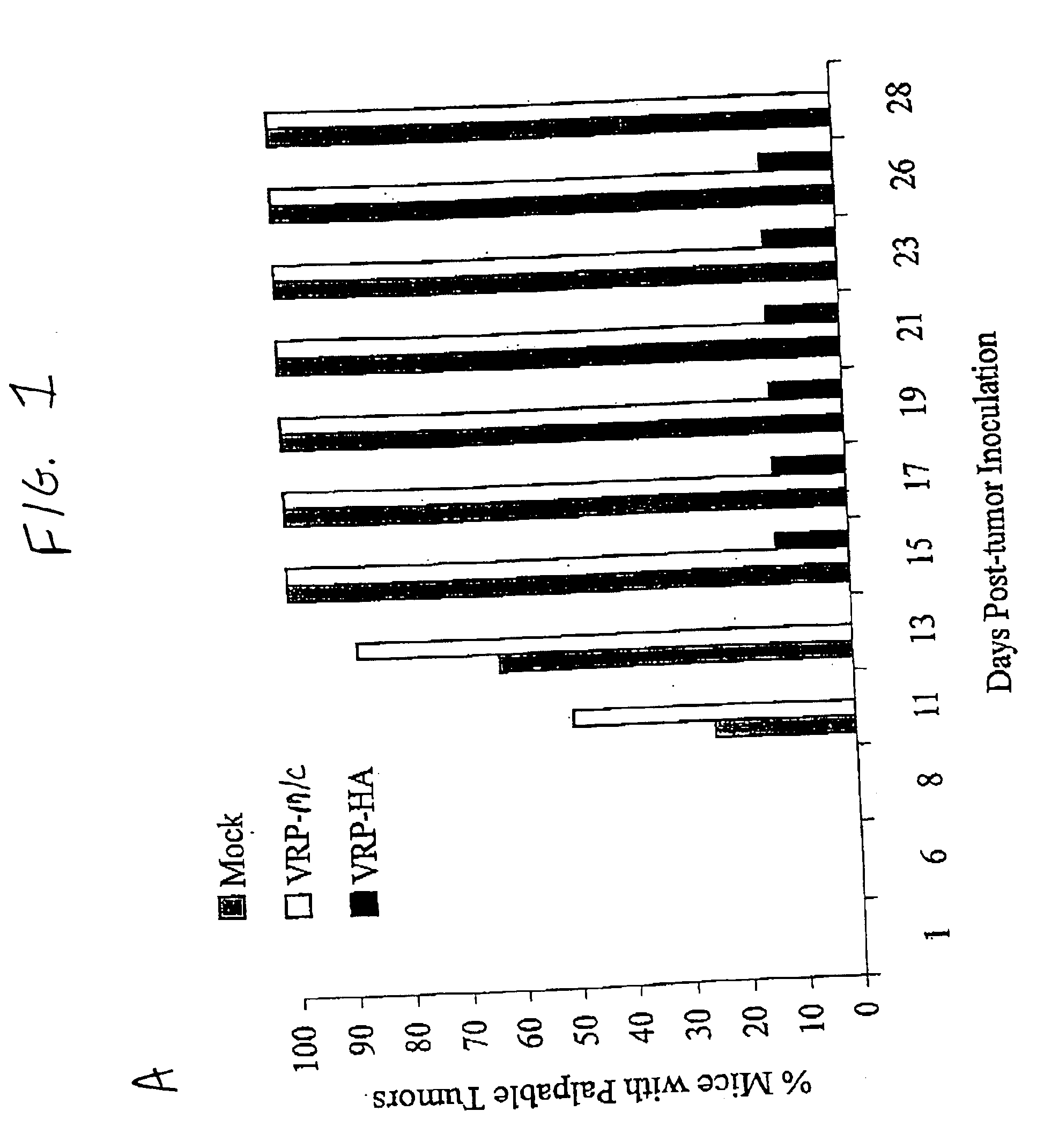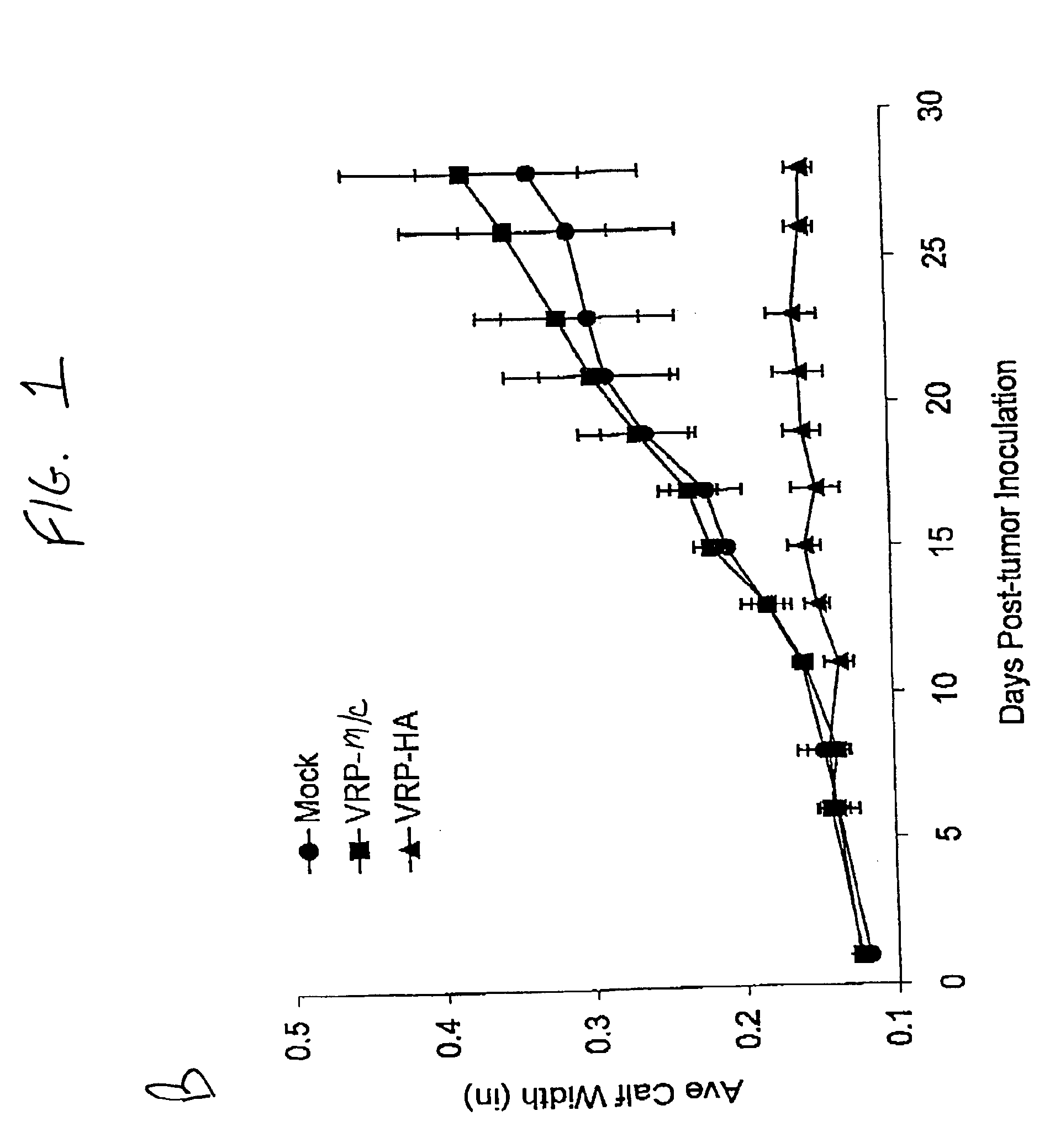Methods and modified cells for the treatment of cancer
a technology of modified cells and cancer, applied in the direction of biocide, antibody medical ingredients, genetic material ingredients, etc., can solve the problems of difficult to obtain large numbers of monocytes from cancer patients, time-consuming vivo differentiation of cells, and difficult to use protocols, etc., to achieve strong immunogenicity, reduce the risk of viral spread and possible virulence, and increase the safety of using live viruses
- Summary
- Abstract
- Description
- Claims
- Application Information
AI Technical Summary
Benefits of technology
Problems solved by technology
Method used
Image
Examples
example 1
[0083]Live virus vaccines: Propagation incompetent, VEE replicon vectors (VRP) previously described (P. Pushko et al., (1998) Virology 239:389-401) were used in these studies to deliver either an artificial tumor antigen, hemagglutinin (HA), from the influenza virus (PR / 8 / 34, type H1N1) (P. Pushko et al., (1998) Virology 239:389-401) or an irrelevant antigen, SIV matrix / capsid, (M / C) (N. L. Davis et al., (1999) Proc. Natl. Acad. Sci. USA, submitted). Specifically, The HA or M / C gene were cloned into the VEE replicon expression vector behind the 26S subgenomic promoter, replacing the structural genes. To minimize the possibility of full length recombinant virus arising during the replicon particle packaging, the structural genes were provided in trans by two separate helper vectors, one expressing VEE capsid and the other expressing the VEE glycoprotein genes. Electroporation of RNA transcripts from all three vectors into baby hamster kidney cells (BHK) resulted in the production of ...
example 2
[0084]The gene for the Influenza hemagglutinin Puerto Rico 8 (A PR8) was excised from the VRep construct using HindIII. It was cloned into pBluescript II SK-(Stratagene) at the HindIII site such that the 5′ end of the gene was on the SalI side of the polylinker (HA PR8-SK). The HA PR8 gene was excised from this construct using SalI and BamHI and cloned into the pH-beta vector (P. Gunning et al., (1987) Proc. Natl. Acad. Sci U.S.A. 84.483.1 at the same sites (HA PR8-pH-beta). This construct drives expression of the introduced gene with the β-actin promoter and contains the gene coding for geneticin resistance.
[0085]The LINE1 mouse lung carcinoma has been described previously. B. A. Pulaski et al., (1993) Cancer Res. 53:2112. HA PR8-pHb was transfected into LINE1 cells via calcium phosphate precipitation as previously described. B. K. Martin et al., (1997) Immunity 6:591. Forty hours after transfection the cells were split 1:20 into media containing geneticin (Sigma, 800 mg / ml). There...
example 3
[0086]Mice: Three groups of 8 BALBC 7-8 week old female mice (Jackson Labs) were inoculated with either 5×105 infectious units (IU) of either V3014-HA VRP, V3014-M / C VRP or diluent (phosphate buffered saline with 1% donor calf serum), subcutaneously in the rear footpad. Mice were boosted three weeks later by the same protocol, and three weeks following were inoculated intramuscularly (im) in the same calf with either 103 LINE1 tumor cells or LINE1 cells expressing HA (LINE1-HA). The growth of the tumor was monitored by comparison of right and left calf diameter. Animals were sacrificed when the tumor diameter exceeded 0.5 inches.
[0087]Sections of tumor and normal muscle were fixed in 4% paraformaldehyde and frozen sections were immunostained with antiserum to flu type H1N1 (kindly provided by R. Webster, St. Jude's Children Hospital, Memphis, Tenn.), visualized using an anti-rabbit-HRP second antibody, and counter-stained with hematoxylin.
PUM
| Property | Measurement | Unit |
|---|---|---|
| diameter | aaaaa | aaaaa |
| size | aaaaa | aaaaa |
| diameter | aaaaa | aaaaa |
Abstract
Description
Claims
Application Information
 Login to View More
Login to View More - R&D
- Intellectual Property
- Life Sciences
- Materials
- Tech Scout
- Unparalleled Data Quality
- Higher Quality Content
- 60% Fewer Hallucinations
Browse by: Latest US Patents, China's latest patents, Technical Efficacy Thesaurus, Application Domain, Technology Topic, Popular Technical Reports.
© 2025 PatSnap. All rights reserved.Legal|Privacy policy|Modern Slavery Act Transparency Statement|Sitemap|About US| Contact US: help@patsnap.com



